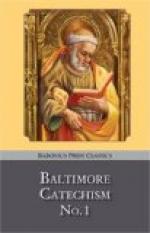The Israelites fell into idolatry chiefly by associating with persons not of the true religion. Let us learn from their sins never to run the risk of weakening or losing our faith by making bosom friends and steady companions of those not of the true religion or of no religion at all. You are not, however, to treat any person with contempt or to despise anyone, but to look upon all as the children of God, and pray for those not of the true religion, that they may be converted and saved.
342 Q. Is it right to show respect to the pictures and images of Christ and His saints? A. It is right to show respect to the pictures and images of Christ and His saints, because they are the representations and memorials of them.
343 Q. Is it allowed to pray to the crucifix or to the images and relics of the saints? A. It is not allowed to pray to the crucifix or images and relics of the saints, for they have no life, nor power to help us, nor sense to hear us.
344 Q. Why do we pray before the crucifix and the images and relics of the saints? A. We pray before the crucifix and the images and relics of the saints because they enliven our devotion by exciting pious affections and desires, and by reminding us of Christ and of the saints, that we may imitate their virtues.
Lesson 32 FROM THE SECOND TO THE FOURTH COMMANDMENT
345 Q. What is the Second Commandment? A. The Second Commandment is: Thou shalt not take the name of the Lord thy God in vain.
“In vain”—that is, without necessity.
346 Q. What are we commanded by the Second Commandment? A. We are commanded by the Second Commandment to speak with reverence of God and of the saints, and of all holy things, and to keep our lawful oaths and vows.
A very common sin against this Commandment is to use the words and sayings of Holy Scripture in a worldly or bad sense. The Church forbids us to use the words and sayings of Holy Scripture to convey any meaning but the one God intended them to convey, or at least to use them in any but a sacred sense.
347 Q. What is an oath? A. An oath is the calling upon God to witness the truth of what we say.
We declare a thing to be so or not, and call God to be our witness that we are speaking truly. This is one of the most solemn acts that men can perform in the presence of their fellowman. All the nations of the earth regard an oath as a most sacred thing, and one who swears falsely is the vilest of men—a perjurer. God is infinite truth and hates lies. What a frightful thing then to call Him to sanction a lie!




